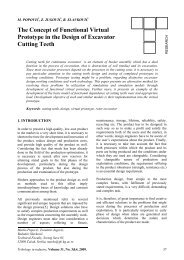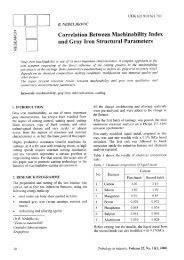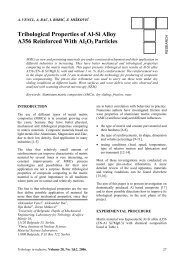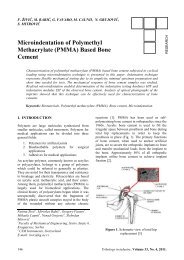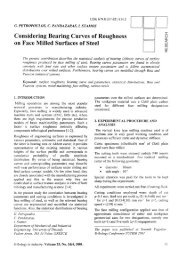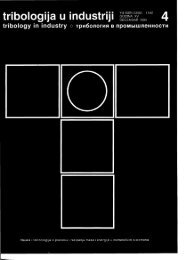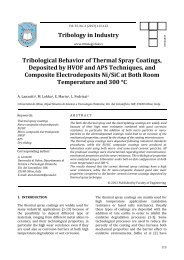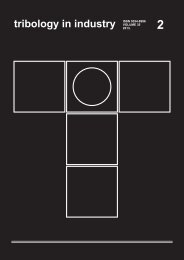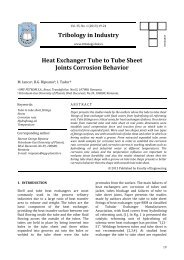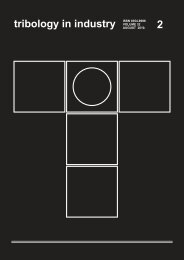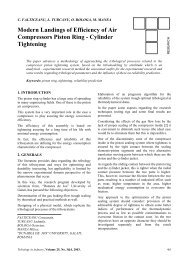No. 4, 1998 - Tribology in Industry
No. 4, 1998 - Tribology in Industry
No. 4, 1998 - Tribology in Industry
You also want an ePaper? Increase the reach of your titles
YUMPU automatically turns print PDFs into web optimized ePapers that Google loves.
3. TRIBOLOGIC,{L ENERGY LOSSES<br />
Tiibological processes, thus, <strong>in</strong>evitatrly cause direct energy<br />
and material losses, and with time this becomes apparent<br />
e$ worsen<strong>in</strong>g of the system's flnctionaiiry and faiiure.<br />
In order to decrease, prevent and elirn<strong>in</strong>ate negative<br />
c()usequences of friction auci wear, differenr ma<strong>in</strong>tenance<br />
activities are be<strong>in</strong>g undertaken. On the other side,<br />
tribologically shorten work<strong>in</strong>g life of technical systerns,<br />
conta<strong>in</strong>eci <strong>in</strong> various equipment, manufactur<strong>in</strong>g means,<br />
transportation means, etc, as a consequence has a need<br />
for new <strong>in</strong>vestments. Consider<strong>in</strong>g that, the negative consequcnces<br />
of tribological processes (tribological losses)<br />
can be irlentified on different levels (Figure 3).<br />
r".1.jt .r' rRr<br />
L_:":r tso r "o Gr cnr.<br />
-__:f<br />
:-"1r_Tl<br />
:<br />
Inl csl.mcnas<br />
Figura 3. Gbbal .correquencas of tibological processcs<br />
The most glol--aiiy considered, they can be of direct and<br />
<strong>in</strong>direci character (Figure 4) with respect to tribological<br />
processes [2].<br />
Direct losses are i<strong>in</strong>nrediate energy ioss due to friction,<br />
arid matenal loss of contact elernents due to wear, as well<br />
irs losses relatecl to ma<strong>in</strong>tenarrce. It comb<strong>in</strong>es diiferent<br />
Teftiary<br />
TRIBOLOGlCAL<br />
LOSSES/SAVINGS<br />
ecti"",ities, like monitor<strong>in</strong>g of changes <strong>in</strong> conditions of<br />
both cornponents and systems, diagnostic of their<br />
functions, as wcli as def<strong>in</strong>ition and undertak<strong>in</strong>g of concrete<br />
actions of ciean<strong>in</strong>g, lubrications. regeneration, repair,<br />
elemenis replacement, etc., what is, however, related<br />
to production of necessary means for ma<strong>in</strong>tenance<br />
and spare parts.<br />
Direct energy losses due to friction are marked as primary<br />
direct losses. These losses are the easiest to spot, and<br />
<strong>in</strong> superficial approach to the problem they are assumed<br />
as equal to total losses of tribological nature. The truth<br />
is that <strong>in</strong> total lost e nertry, <strong>in</strong> technical systems function<strong>in</strong>g,<br />
the large share belongs to losses due to friction.<br />
thus, fricticn is the important cause of low efficiency<br />
ratio of technical systems.<br />
The secondary direct losses are ma<strong>in</strong>ly relateC to necessity<br />
of produc<strong>in</strong>g and replacement of the worn criiical<br />
elements of the tribomechanical systems, and lubrication<br />
<strong>in</strong> orcler to decrease <strong>in</strong>tensity of friction and wear. With<br />
that it shoulci be kept <strong>in</strong> m<strong>in</strong>d that the requirement for<br />
simulti<strong>in</strong>eous decrease of friction and wear is not always<br />
present, what is compatible. Sometimes is present the<br />
requirement for <strong>in</strong>crease clf friction and simultaneous<br />
decrease of wear (wheel/track, car tires/road, brakes,<br />
frictional transmissions, etc.). N{aterial mach<strong>in</strong><strong>in</strong>g for<br />
replac<strong>in</strong>g the worn elements nssume set of technologies<br />
<strong>in</strong> which the energr is consunred, what can also be quantified<br />
energetically.<br />
The tertiary direct losses, namely sav<strong>in</strong>gs, are ma<strong>in</strong>ly<br />
related to material for manufactur<strong>in</strong>g the worn elements.<br />
Amount of losses/sav<strong>in</strong>gs is proportional to enerry equivalent<br />
of material and price. Every loss/sav<strong>in</strong>g on the<br />
primarl level of lower<strong>in</strong>g the friction and wear most<br />
frequently res,,rlts <strong>in</strong> even higher effects on the secondary<br />
and teriiary level.<br />
Same as prirnary and secondary losses, the tertiary losses<br />
also have dimension of energy. Namely, the metal mach<strong>in</strong><strong>in</strong>g<br />
procedures, as rvell as the material itself that is used<br />
for manufar:tur<strong>in</strong>g the triboelements, have their own<br />
enertry equivalent [2].<br />
Indirect losscslsav<strong>in</strong>gs come as a consequence of direct<br />
ones of any k<strong>in</strong>d. Losses due to delays (prirnary <strong>in</strong>direct<br />
losses) are economicaily very irnportant, but they do not<br />
have the energy d<strong>in</strong>rension. The secondary <strong>in</strong>direct sav<strong>in</strong>gs<br />
of tribologic:rl nature reflect on the capital <strong>in</strong>vestments<br />
plan, and lot only through money, but also<br />
through energy and rnaterial. Here we th<strong>in</strong>k of <strong>in</strong>vestments<br />
that are consequence of tribologically decreased<br />
work<strong>in</strong>g life of equiprnent, as well as the need for <strong>in</strong>creas<strong>in</strong>g<br />
the efficiency.<br />
Figure 4. Gicbal clatsificatk:rt of ttibological losscshav<strong>in</strong>gs<br />
150<br />
Tribolog' irt irulustry, Volunte 20, <strong>No</strong>. 4, <strong>1998</strong>.



